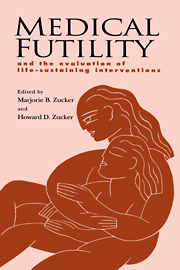Book contents
- Frontmatter
- Contents
- Preface
- Foreword
- Contributors
- 1 Medical futility: a useful concept?
- 2 Death with dignity?
- 3 Physicians and medical futility: experience in the critical care setting
- 4 Physicians and medical futility: experience in the setting of general medical care
- 5 Futility issues in pediatrics
- 6 Medical futility: a nursing home perspective
- 7 Alternative medicine and medical futility
- 8 How culture and religion affect attitudes toward medical futility
- 9 When religious beliefs and medical judgments conflict: civic polity and the social good
- 10 Conflict resolution: experience of consultation-liaison psychiatrists
- 11 Ethics committees and end-of-life decision making
- 12 The economics of futile interventions
- 13 Medical futility: a legal perspective
- 14 Professional and public community projects for developing medical futility guidelines
- 15 Community futility policies: the illusion of consensus?
- 16 Not quite the last word: scenarios and solutions
- Index of cited authors, cases, and statutes
- Subject index
12 - The economics of futile interventions
Published online by Cambridge University Press: 11 September 2009
- Frontmatter
- Contents
- Preface
- Foreword
- Contributors
- 1 Medical futility: a useful concept?
- 2 Death with dignity?
- 3 Physicians and medical futility: experience in the critical care setting
- 4 Physicians and medical futility: experience in the setting of general medical care
- 5 Futility issues in pediatrics
- 6 Medical futility: a nursing home perspective
- 7 Alternative medicine and medical futility
- 8 How culture and religion affect attitudes toward medical futility
- 9 When religious beliefs and medical judgments conflict: civic polity and the social good
- 10 Conflict resolution: experience of consultation-liaison psychiatrists
- 11 Ethics committees and end-of-life decision making
- 12 The economics of futile interventions
- 13 Medical futility: a legal perspective
- 14 Professional and public community projects for developing medical futility guidelines
- 15 Community futility policies: the illusion of consensus?
- 16 Not quite the last word: scenarios and solutions
- Index of cited authors, cases, and statutes
- Subject index
Summary
Futile interventions are usually expensive. Few dispute this. The question is whether limits on futile interventions will lead to significant savings. Some believe that the modest savings from futile intervention policies are not worth the burdens of these policies. Why change our ethics, law, and guidelines for medical decision making when truly futile interventions are so rare?
In this chapter, I argue that the actual cost savings of limiting futile interventions are small, but the potential cost savings are great if we consider futility in a larger context. The futile intervention debate is one of the main arenas in which our society is experiencing a cultural shift. We need to make the transition – painfully and slowly – from the rugged individualism that formed our country to a more communitarian ethic that will help us survive (and perhaps thrive) in the next century.
I consider the cost savings associated with futile interventions at three levels. First, I will review the cost savings of futile interventions that have been documented to date. Second, I consider the cost savings when we expand the futile intervention debate to include inappropriate interventions. Defining inappropriate interventions will require a change in doctors' and patients' attitudes about care near the end of life. These attitude changes could lead to significant cost savings. Third, I argue that a fundamental change in our culture is essential to control health care costs.
- Type
- Chapter
- Information
- Medical FutilityAnd the Evaluation of Life-Sustaining Interventions, pp. 123 - 135Publisher: Cambridge University PressPrint publication year: 1997
- 1
- Cited by

